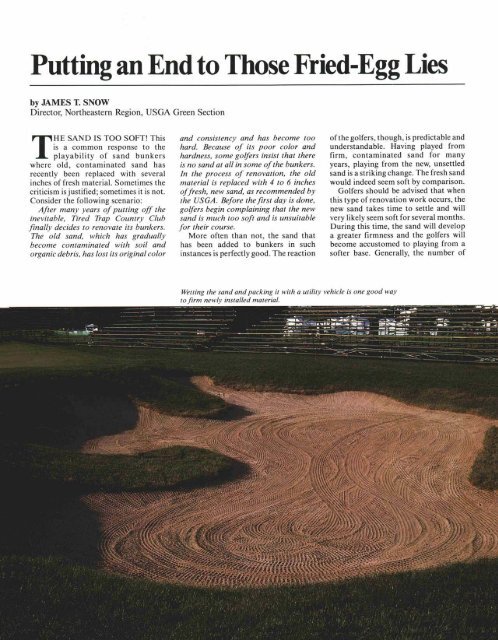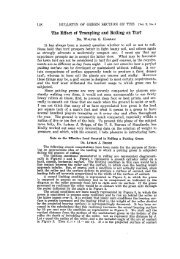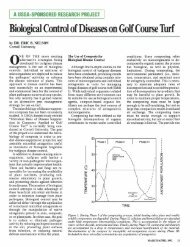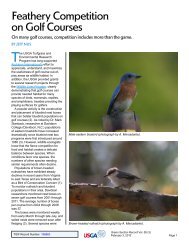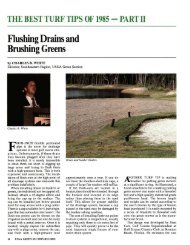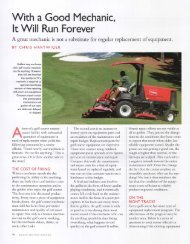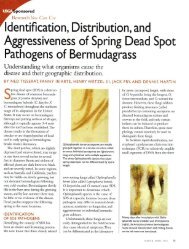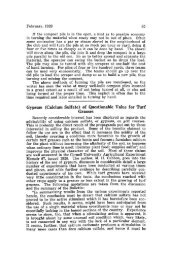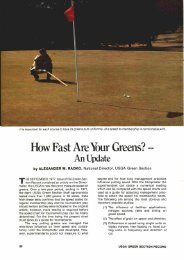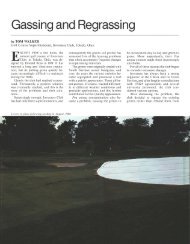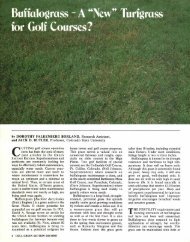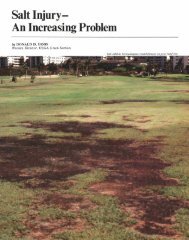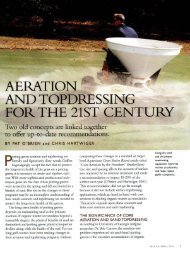Putting an End to Those Fried-Egg Lies - USGA Green Section Record
Putting an End to Those Fried-Egg Lies - USGA Green Section Record
Putting an End to Those Fried-Egg Lies - USGA Green Section Record
You also want an ePaper? Increase the reach of your titles
YUMPU automatically turns print PDFs into web optimized ePapers that Google loves.
<strong>Putting</strong> <strong>an</strong> <strong>End</strong> <strong>to</strong> <strong>Those</strong> <strong>Fried</strong>-<strong>Egg</strong> <strong>Lies</strong>by JAMES T. SNOWDirec<strong>to</strong>r, NortheasternRegion, <strong>USGA</strong> <strong>Green</strong> <strong>Section</strong>THE SAND IS TOO SOFT! Thisis a common response <strong>to</strong> theplayability of s<strong>an</strong>d bunkerswhere old, contaminated s<strong>an</strong>d hasrecently been replaced with severalinches of fresh material. Sometimes thecriticism is justified; sometimes it is not.Consider the following scenario:After m<strong>an</strong>y years of putting off theinevitable, Tired Trap Country Clubfinally decides <strong>to</strong> renovate its bunkers.The old s<strong>an</strong>d, which has graduallybecome contaminated with soil <strong>an</strong>dorg<strong>an</strong>ic debris, has lost its original color<strong>an</strong>d consistency <strong>an</strong>d has become <strong>to</strong>ohard. Because of its poor color <strong>an</strong>dhardness, some golfers insist that thereis no s<strong>an</strong>d at all in some of the bunkers.In the process of renovation, the oldmaterial is replaced with 4 <strong>to</strong> 6 inchesof fresh, new s<strong>an</strong>d, as recommended bythe <strong>USGA</strong>. Before the first day is done,golfers begin complaining that the news<strong>an</strong>d is much <strong>to</strong>o soft <strong>an</strong>d is unsuitablefor their course.More often th<strong>an</strong> not, the s<strong>an</strong>d thathas been added <strong>to</strong> bunkers in suchinst<strong>an</strong>ces is perfectly good. The reactionof the golfers, though, is predictable <strong>an</strong>dunderst<strong>an</strong>dable. Having played fromfirm, contaminated s<strong>an</strong>d for m<strong>an</strong>yyears, playing from the new, unsettleds<strong>an</strong>d is a striking ch<strong>an</strong>ge. The fresh s<strong>an</strong>dwould indeed seem soft by comparison.Golfers should be advised that whenthis type of renovation work occurs, thenew s<strong>an</strong>d takes time <strong>to</strong> settle <strong>an</strong>d willvery likely seem soft for several months.During this time, the s<strong>an</strong>d will developa greater firmness <strong>an</strong>d the golfers willbecome accus<strong>to</strong>med <strong>to</strong> playing from asofter base. Generally, the number ofWetting the s<strong>an</strong>d <strong>an</strong>d packing it with a utility vehicle is one good way<strong>to</strong> firm newly installed material.
(Opposite page, <strong>to</strong>p) One way <strong>to</strong> test different s<strong>an</strong>ds prior <strong>to</strong> a s<strong>an</strong>d bunker renovation(Opposite page, bOllom) A cement finisher c<strong>an</strong> be used <strong>to</strong> quickly firm soft s<strong>an</strong>d.(Above) H<strong>an</strong>d raking smoothes the surface without loosening the s<strong>an</strong>d.program.complaints diminishes once the news<strong>an</strong>d has been in place for several weeks.Another complicating fac<strong>to</strong>r isgolfers' preferences for; different typesof bunker s<strong>an</strong>ds. Some prefer firms<strong>an</strong>ds, while others like softer s<strong>an</strong>ds.On the other h<strong>an</strong>d, it is possible thatthe new s<strong>an</strong>d is indeed <strong>to</strong>o soft. Underthese circumst<strong>an</strong>ces it could take yearsof contamination with soil <strong>an</strong>d org<strong>an</strong>icdebris before a good firmness develops,during which time golfers would besubjected <strong>to</strong> poor playing conditions<strong>an</strong>d fried-egg lies.The difference between a goodqualitys<strong>an</strong>d that is temporarily softafter installation <strong>an</strong>d a s<strong>an</strong>d that will be<strong>to</strong>o soft for months or years <strong>to</strong> come isnot easy <strong>to</strong> detect, especially from avisual st<strong>an</strong>dpoint. The best way <strong>to</strong> avoida s<strong>an</strong>d that is <strong>to</strong>o soft is <strong>to</strong> do yourhomework. Contact clubs in your areafor recommendations, <strong>an</strong>d talk <strong>to</strong> theirgolf course superintendents, golf professionals,<strong>an</strong>d other club members forcomments. Play their courses if you c<strong>an</strong>,especially if their s<strong>an</strong>d has recently beeninstalled.If locally used s<strong>an</strong>ds are unsuitablefor play or from a budget st<strong>an</strong>dpoint,then a search must be made of localquarries for a satisfac<strong>to</strong>ry s<strong>an</strong>d. Contactthe regional office of the <strong>USGA</strong> <strong>Green</strong><strong>Section</strong> in your area for guidelines inselecting bunker s<strong>an</strong>ds, <strong>an</strong>d use theparticle size r<strong>an</strong>ge, particle shape, <strong>an</strong>dchemical composition parameters fromthe guidelines <strong>to</strong> help sort out thepotentially useful s<strong>an</strong>ds.IF THERE is <strong>an</strong>y doubt about yourchoice, send samples of the bestlookings<strong>an</strong>ds <strong>to</strong> a soils labora<strong>to</strong>ry thatis experienced in evaluating s<strong>an</strong>ds forbunker use. The lab should be able <strong>to</strong>provide a description of the playabilityof each s<strong>an</strong>d <strong>an</strong>d discuss <strong>an</strong>y potentialproblems, allowing the choice <strong>to</strong> be narroweddown <strong>to</strong> one or several selections.If doubts remain, install differents<strong>an</strong>ds in a limited number of bunkers onthe course or in several test bunkers forfurther evaluation. After a few monthsor a season of use, the best s<strong>an</strong>d shouldbe apparent.Having <strong>to</strong> take all of these steps <strong>to</strong>find a suitable, affordable bunker s<strong>an</strong>dJANUARY/FEBRUARY 1990 3
is not common, but m<strong>an</strong>y courses paya high price for not taking the time <strong>to</strong>fully investigate <strong>an</strong>d test the s<strong>an</strong>d theyare placing in their bunkers. M<strong>an</strong>y acourse has gone through the disruption<strong>an</strong>d expense of replacing old bunkers<strong>an</strong>d, only <strong>to</strong> go through the wholeprocess again within a year or twobecause the members were unhappywith the material.When a s<strong>an</strong>d already has been installedin a bunker <strong>an</strong>d is found<strong>to</strong> be <strong>to</strong>o soft, there are a number of differentsteps that c<strong>an</strong> be taken <strong>to</strong> correctthe problem. If the s<strong>an</strong>d is extremelysoft <strong>an</strong>d fried-egg lies are common, senda sample <strong>to</strong> a good soil-testing labora<strong>to</strong>ryfor evaluation. If the lab suggeststhat the s<strong>an</strong>d will be a problem for sometime <strong>to</strong> come, it might recommend adifferent s<strong>an</strong>d, with a distinctly differentparticle size r<strong>an</strong>ge, be mixed with theexisting s<strong>an</strong>d <strong>to</strong> give it greater stability.For best results, the existing materialsshould be removed from the bunker <strong>an</strong>dmixed off-site with the new s<strong>an</strong>d. Thisprocedure would be feasible with onlya bunker or two involved, but on-sitemixing would be the only practicalalternative if the s<strong>an</strong>d in all or m<strong>an</strong>y ofthe bunkers had <strong>to</strong> be modified.Before <strong>an</strong> expensive s<strong>an</strong>d replacemen<strong>to</strong>r modification procedure is instituted,though, there are a number ofrelatively simple practices for firmingsoft s<strong>an</strong>d that should be tried. Forexample, if the depth of the s<strong>an</strong>d in thebunker is 6 inches or more, then reduceit <strong>to</strong> about 4 inches in the flat areas <strong>an</strong>d2 <strong>to</strong> 3 inches on the faces. Since thedegree of fluffiness of the s<strong>an</strong>d isdirectly related <strong>to</strong> its depth, removingsome of the excess s<strong>an</strong>d should minimizethe potential for fried-egg lies.When s<strong>an</strong>d depth is at a 4-inch level,though, it is often difficult <strong>to</strong> use amech<strong>an</strong>ical rake without digging in<strong>to</strong>the soil in the base of the bunker. Thismethod of firming s<strong>an</strong>d, then, requirescareful use of the mech<strong>an</strong>ical rake,modifications <strong>to</strong> the rake <strong>to</strong> reduceits cultivating activity, or more h<strong>an</strong>draking.Another good approach <strong>to</strong> firmingsoft s<strong>an</strong>d is <strong>to</strong> try <strong>to</strong> pack the particlescloser <strong>to</strong>gether. Some s<strong>an</strong>ds pack moretightly th<strong>an</strong> others. Sometimes, irrigatingthe s<strong>an</strong>d is all that is necessary<strong>to</strong> adequately reduce its fluffiness. Abetter method is <strong>to</strong> wet the s<strong>an</strong>dthoroughly <strong>an</strong>d run back <strong>an</strong>d forthm<strong>an</strong>y times across the surface with atrac<strong>to</strong>r, a riding mech<strong>an</strong>ical rake withthe cultiva<strong>to</strong>r bar removed, or a utilityvehicle of some type.An excellent compaction techniquefor firming s<strong>an</strong>ds involves the use of acement finisher (a steel plate mounted<strong>to</strong> a gasoline-powered engine that producesa compacting effect by vibratinghorizontally). After the s<strong>an</strong>d has beenthoroughly watered, the machine isused <strong>to</strong> compact the s<strong>an</strong>d <strong>to</strong> the desiredfirmness. The compac<strong>to</strong>r c<strong>an</strong> be rentedby the day from most rental outlets, orit c<strong>an</strong> be purchased for less th<strong>an</strong> $1,500if a large-scale s<strong>an</strong>d-replacement programis <strong>an</strong>ticipated. For more information,see "A Technique For DealingWith Soft S<strong>an</strong>d" in the March/April 1989issue of the GREEN SECTIONRECORD.As noted earlier, irrigation is a goodmethod for temporarily firming a softs<strong>an</strong>d. Ironically, s<strong>an</strong>ds that are rakedwhen they are wet tend <strong>to</strong> be especiallyfluffy as they dry out. Because of thesurface tension of water, wet s<strong>an</strong>dparticles tend <strong>to</strong> bridge more readilywhen they are cultivated <strong>an</strong>d thereforedevelop a looser texture. As dryingoccurs, the structure of the s<strong>an</strong>dremains intact until it is subjected <strong>to</strong>traffic. This is quite a common effect,since irrigation is often done during thenight, <strong>an</strong>d s<strong>an</strong>d bunkers are usuallyraked during the early morning hours.Removing the cultivation bar <strong>an</strong>d adding lead weights <strong>to</strong> the smoothing apparatus isone way <strong>to</strong> modify the mech<strong>an</strong>ical rake for accommodating soft s<strong>an</strong>d.To PARTIALLY overcome the softs<strong>an</strong>dproblem that occurs when wets<strong>an</strong>d particles are raked, m<strong>an</strong>y coursesregularly use wetting agents in theirbunkers. Since the wetting agent reducesthe surface tension of water, thebridging effect is reduced <strong>an</strong>d the s<strong>an</strong>dis better able <strong>to</strong> retain its firmness aftercultivation. To be effective, the wettingagent must be used regularly, as oftenas once per week during periods offrequent irrigation or rainfall <strong>an</strong>dregular cultivation. Only light rates ofwetting agents need be applied, <strong>an</strong>dnearly <strong>an</strong>y product is satisfac<strong>to</strong>ry forthis use as long as it is non-phy<strong>to</strong><strong>to</strong>xic.This practice is most likely feasiblewhen just a few bunkers are involved.Other me<strong>an</strong>s of firming s<strong>an</strong>ds should beconsidered when dealing with a largenumber of bunkers.In trying <strong>to</strong> develop greater firmnessin a naturally soft s<strong>an</strong>d, two generalstrategies must be adopted. The firstinvolves filling more of the pore spacebetween the s<strong>an</strong>d particles by way ofcompaction techniques or by addings<strong>an</strong>d particles of a different size. Thishas been the theme of the practicesmentioned in the discussion thus far.4 <strong>USGA</strong> GREEN SECTION RECORD
The second strategy consists of subjectingthe s<strong>an</strong>d <strong>to</strong> as little cultivationas possible. This makes sense, becausecultivation is a loosening process thatwould only make a soft s<strong>an</strong>d softer.Unfortunately, raking is <strong>an</strong> integral par<strong>to</strong>f s<strong>an</strong>d bunker mainten<strong>an</strong>ce, serving <strong>to</strong>keep the surface smooth <strong>an</strong>d <strong>to</strong> keepweeds in check. A compromise must bereached, then, <strong>to</strong> serve these opposingneeds.A typical s<strong>an</strong>d-raking program atm<strong>an</strong>y courses involves the use of ariding mech<strong>an</strong>ical s<strong>an</strong>d rake as little asonce or twice per week <strong>to</strong> as often asonce per day. The rake usually isequipped with teeth or a bar thatcultivates <strong>to</strong> a depth of several inches.What's more, the opera<strong>to</strong>r usually makesnumerous passes around a bunker <strong>to</strong> doa thorough job of smoothing <strong>an</strong>d cultivatingevery square inch of s<strong>an</strong>d.Given the frequency <strong>an</strong>d depth <strong>to</strong>which bunker s<strong>an</strong>d is raked, it is notsurprising that there are so m<strong>an</strong>ycomplaints about fried-egg lies in newlyinstalled s<strong>an</strong>ds. If the objective is <strong>to</strong>maintain greater s<strong>an</strong>d firmness, then itis clear that cultivation depth <strong>an</strong>dfrequency should be reduced. Therefore,instead of raking the bunkers sixor seven days per week, reduce it <strong>to</strong> onceor twice per week, if possible. On dayswhen the mech<strong>an</strong>ical rake is not used,<strong>to</strong>uch up footprints <strong>an</strong>d other irregu-'" larities with h<strong>an</strong>d rakes.ANOTHER OPTION is <strong>to</strong> modify the~mech<strong>an</strong>ical rake so that it smoothsthe surface without doing much cultivationor loosening of the s<strong>an</strong>d. Cultivatingteeth c<strong>an</strong> be shortened, or thecultivating bar c<strong>an</strong> be raised or removed,for example. Golf course superintendentshave come up with all kindsof homemade accessories for themech<strong>an</strong>ical rake which work very wellfor smoothing s<strong>an</strong>d while doing aminimal amount of cultivation. Fromtime <strong>to</strong> time the cultivating bar c<strong>an</strong> betemporarily reinstalled on the machine<strong>to</strong> control developing weeds in thebunkers.Regular use of the mech<strong>an</strong>ical rakecauses other s<strong>an</strong>d softness problems aswell. When used frequently <strong>an</strong>d at fastspeeds, the rake c<strong>an</strong> redistribute thes<strong>an</strong>d throughout the bunker <strong>an</strong>d causea wide variation in s<strong>an</strong>d depth. It is notuncommon <strong>to</strong> find 8 <strong>to</strong> 10inches of s<strong>an</strong>din some areas <strong>an</strong>d only 2 <strong>to</strong> 3 inches inother locations. Naturally, softnessproblems are more prevalent in areaswhere the s<strong>an</strong>d is deeper. S<strong>an</strong>d depth,Moving s<strong>an</strong>d fromwhere it is <strong>to</strong>o deep <strong>to</strong> where it is <strong>to</strong>o shallow.therefore, should be closely moni<strong>to</strong>redin bunkers where the mech<strong>an</strong>ical rakeis often used.As noted before, m<strong>an</strong>y courses arereducing their use of the mech<strong>an</strong>icalrake <strong>an</strong>d relying more <strong>an</strong>d more onh<strong>an</strong>d raking. The misuse of themech<strong>an</strong>ical rake is a key fac<strong>to</strong>r withrespect <strong>to</strong> keeping soft s<strong>an</strong>ds soft,hastening the contamination of goods<strong>an</strong>ds with soil <strong>an</strong>d other debris, <strong>an</strong>dcausing the deterioration of bunkeredges <strong>an</strong>d lips. Indeed, h<strong>an</strong>d raking is<strong>an</strong> excellent me<strong>an</strong>s of keeping soft s<strong>an</strong>dfirmer while keeping the surface of thes<strong>an</strong>d smooth <strong>an</strong>d playable. M<strong>an</strong>y stylesof rakes are for sale, <strong>an</strong>d some are verywell suited for this purpose. Some haveshort, stubby, cultivating teeth, whileothers have none at all. H<strong>an</strong>d rakingprograms require more labor time, butm<strong>an</strong>y courses find that the improvementin playability <strong>an</strong>d the red uced rateof s<strong>an</strong>d <strong>an</strong>d bunker edge deteriorationare import<strong>an</strong>t compensating fac<strong>to</strong>rs.Most of the options for dealing withfluffy bunker s<strong>an</strong>ds are temporary measures.They are usually quite adequate,though, because all bunker s<strong>an</strong>ds aresubject <strong>to</strong> soil <strong>an</strong>d org<strong>an</strong>ic mattercontamination that makes them firmerover a period of time. Silt <strong>an</strong>d clayparticles from the base of the bunker<strong>an</strong>d from its edges eventually becomeintermixed with the s<strong>an</strong>d <strong>to</strong> fill porespaces <strong>an</strong>d bind the s<strong>an</strong>d. Soil, dust, <strong>an</strong>dorg<strong>an</strong>ic debris also find their way <strong>to</strong> thebunkers by way of wind, mowing <strong>an</strong>dedging practices, or other me<strong>an</strong>s. Astime goes by, then, the problemsencountered with soft s<strong>an</strong>ds <strong>an</strong>d friedegglies gradually disappear.Whether or not <strong>to</strong> use geotextileliners in s<strong>an</strong>d bunkers is <strong>an</strong> arguablepoint. It is a fac<strong>to</strong>r, though, in a bunkerrenovation program where a soft s<strong>an</strong>dis being used. Because a liner c<strong>an</strong>, withluck, remain in place for a number ofyears <strong>an</strong>d greatly reduce the rate of soilcontamination from import<strong>an</strong>t sources(i.e., the base <strong>an</strong>d edges of the bunker),it c<strong>an</strong> subst<strong>an</strong>tially increase the amoun<strong>to</strong>f time it takes for a very soft s<strong>an</strong>d <strong>to</strong>become firmer. Where the use of linersis being considered, therefore, it is evenmore import<strong>an</strong>t <strong>to</strong> test the s<strong>an</strong>d that willbe used <strong>to</strong> be sure that it is not <strong>to</strong>o soft.S<strong>an</strong>d bunkers are import<strong>an</strong>t <strong>an</strong>d expensivefeatures on m<strong>an</strong>y golf courses,<strong>an</strong>d they are a source of criticism form<strong>an</strong>y golf course superintendents <strong>an</strong>dclub officials. Complaints about softs<strong>an</strong>d <strong>an</strong>d fried-egg lies, however, neednot occur if reasonable caution is takenin selecting, installing, <strong>an</strong>d m<strong>an</strong>agingbunker s<strong>an</strong>ds.JANUARY/FEBRUARY 1990 5


